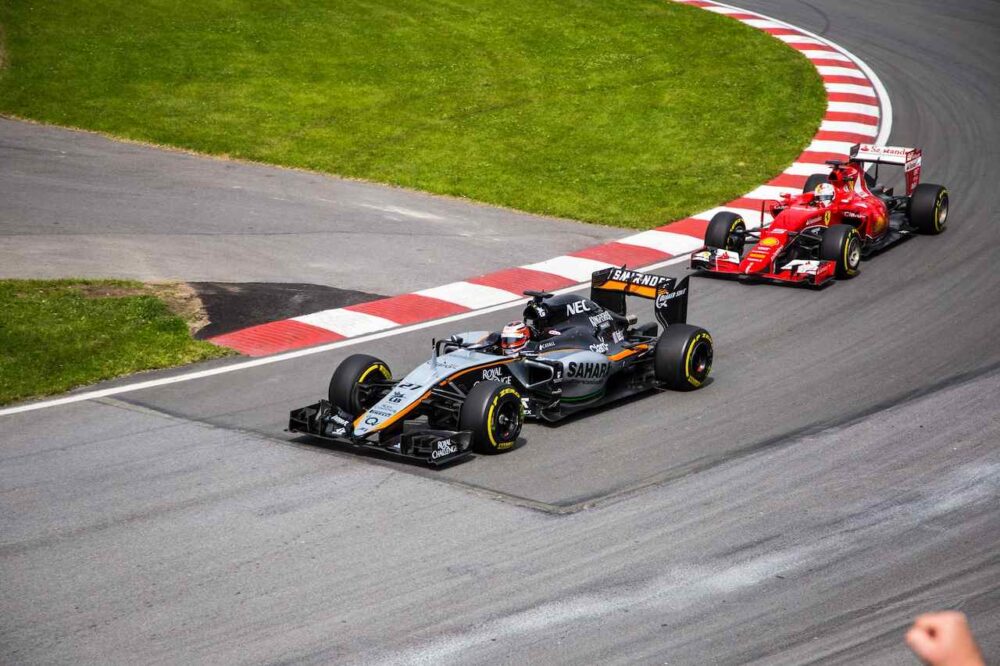Traditionally, at the end of the next decade for Formula 1, many sports portals sum up the results and make rankings such as top 5 drivers of the decade, the most powerful cars, etc. We also decided to join this tradition and compile our rating.
We would like to draw your attention at once, that ranking may be subjective. It is formed solely on the basis of personal opinion and knowledge of the author of the article. But nevertheless, there are certain criteria for estimating balids. This list is based on the qualification place, which is taken into account for general analysis, but not as a major criterion. At the same time, the evaluation was done in terms of car speed, manoeuvrability, handling and overall performance for the team.
10. Force India VJM10 (2017)
The history of Force India (now Racing Point) has its roots in Jordan, Eddie Jordan’s famous private team that regularly competed for podiums and could potentially have swung for the title in 1999. Vijay Malia had acquired the team when it had changed hands a number of times and was hanging around the bottom of the standings. Few would have thought that Mallya would be able to take Force India to the same level as Jordan had once been. But Vijay almost succeeded.
Force India finished the 2016 season in fourth place in the Constructors’ Cup and had already become the best private Formula One team, which in itself is very prestigious. But the following year a new technical regulation came into force – in the championship downforce returned. And then the engineers under the leadership of Andrew Green managed with a minimum budget (and not without problems at first) to build a stable and fast car – VJM10. Thanks to him, “Force India” has collected almost two hundred points, and once again became the best of the private team, ahead of Williams, Renault, McLaren and others.
9. Sauber C31 (2012)
The C31 was Sauber’s (and Alfa Romeo’s) best car of the past decade. It nearly won its second race of the season – the Malaysian Grand Prix. Then Sergio Perez quickly caught up with the leading Ferrari Alonso and was very close to a successful attack, but in the end slipped on the kerb and was forced to retreat. In the course of the race Checo was asked to drive more carefully – some believe that by doing so Sauber, who used Scuderia motors, preferred not to spoil relations with his partner. If so, then now the team from Hinville is unlikely to have the name of “Alfa Romeo” – the Grand Prix, perhaps, was for the team fateful.
After second place in Malaysia Perez made the podium two more times, and at Suzuka Kamui Kobayashi finished third. C31, designed by James Key, was very fast, although at times capricious – on some tracks, it was impossible to set it up. At the same time, the car was not always good in qualifying, but a stable pace on the long series and accurate work with the rubber have brought “Sauber” 126 points and sixth place in the Cup of designers. That season has shown that Hinwil has managed to fully recover from the departure of BMW, but for seven years now the team has been unable to achieve the same results.
8. Renault R31 (2011)
Vitaly Petrov used this car to win the first podium for Russian drivers in Formula One – at the 2011 Australian Grand Prix. Designed by James Ellison (who now builds the champion Mercedes for Hamilton) the car featured a unique “front exhaust” – the gases underneath the bottom of the car created extra downforce. At the second stage of the season – in Malaysia – Nick Heidfeld finished third and brought the team another podium. At the time Enstone was just six points behind Ferrari in the constructors’ cup.
But with the flow of the season it became clear that the chassis does not work very well on slow tracks, and fundamentally improve the car at such an exhaust was impossible. The results gradually decreased, the output in the final segment was becoming less and less. Nevertheless, Lotus-Renault (exactly as it was written in the official application) took fifth place in the Cup of designers, becoming the strongest among the average. This team will become Lotus next year, with Kimi Raikkonen joining them.
7. “Williams FW36 (2014)
Mercedes benefited the most from the switch to turbo-hybrid engines – in the face of stringent aerodynamics restrictions, the powertrain was the key to success. In principle, already one German engine Williams could be enough to get ahead of everyone else and come on the podium. But then the team was not enough – in Austria, Felipe Massa won the pole position (the only case in the season, when “Mercedes” missed out on the pole).
The engineers continued to develop the chassis, and in the second half of the season Williams became almost the fastest car since Mercedes – six podiums for Bottas and three for Massa in the last twelve Grand Prix. For the first time since his partnership with BMW, Grove has been a regular contender for wins. The third place in the Constructors’ Cup was the best in a decade. It seemed then that Williams were about to add a little and return to the top of the podium, but that (so far) hasn’t happened.
6. “Lotus” E20 (2012)
Kimi Raikkonen has returned to Formula One with this car after a break. No one knew in what form the veteran would be, in addition to the new car broke down in the winter testing. But when the reliability problems were solved, Lotus became a regular contender on the podium – Raikkonen and Grozen together nine times finished in the top-3, before the Finn won in Abu Dhabi and said the famous phrase “Leave me alone, I know what I’m doing”.
The 2013 season got off to an even better start with Kimi winning the Australian Grand Prix and retaining the championship lead, with Lotus once again struggling for podiums on a regular basis (14 against 11 the year before!). However, Raikkonen’s departure and the 2014 regulations hit Enstone hard – neither as a Lotus nor as a Renault team won any more.
5. “Ferrari” SF70H (2017)

For Maranello, the switch to turbo hybrids proved more of a challenge, with Ferrari losing even more to Mercedes than it had previously lost to Red Bull. In 2017, however, the SF70H changed all that – under the direction of technical director Mattia Binotto, the engineers created a far more efficient car. For the first time in a long time, Ferrari were able to battle relatively evenly with the Silver Arrows.
Yes, a lot went wrong in that season – pilots made mistakes, the car broke down, but overall the team scored a record 522 points for itself. It was the first year when the technical advantage of Mercedes was not evident. And for Mattia Binotto, the success of the SF70H – and the SF71H, its successor – was a springboard to the position of team manager.
4. “McLaren MP4-27 (2012)
The last great McLaren – and the only car that went faster than Red Bull and was even more unreliable. Qualifying for the Australian Grand Prix ended in something of a sensation, with the McLarens taking the entire front row for the first time in three years and the Red Bulls falling behind. Button and Hamilton had secured five podiums in the first three races and moved the team into the championship lead.
Alas, how fast, how capricious was this “McLaren”, and therefore the machine could suddenly become unmanageable and fight for places at the end of the top 10, and at times it was not equal. For example, the McLaren went into the summer break with a win in Hungary, followed it up with three wins, but ended up only third in the Constructors’ Cup.
Martin Whitmarsh, who then led the team, decided that the MP4-27 was the limit of development of the car concept and instructed to develop for the season-2013 entirely new chassis, although in 2014 came into force of the new technical regulations. The decision has not justified itself: Grand Prix of Brazil 2012 is still the last victory of “McLaren” in Formula 1.
3. “Mercedes W08, W09 and W10 (2017-2019)
With the return of advanced aerodynamics in 2017, Mercedes lost some of its edge, but remained a dominant force in Formula One and took its series of double championship wins (individual title + constructors’ cup) to six. Never before in the history of the Grand Prix has there been such dominance.
Uniqueness of the achievement and engineers team highlights the fact that if before the advantage of the team was built on a powerful propulsion system, and in demanding to aerodynamics circuits (Monaco, Singapore) “Mercedes” sometimes inferior, but now the engineers have revised approach and squeeze the maximum out of aerodynamics. The engine is still powerful, but now it’s not the team’s main weapon.
This is the third car James Ellison in our ranking. It will not be an exaggeration, that in this decade, the British engineer has become the new big technical genius after Adrian Newey.
2. “Red Bull RB6, RB7, RB8 and RB9 (2010-2013)
The past decade began with Red Bull’s sensational dominance as the carbonated drinks manufacturer beat the established Formula One grands (McLaren and Ferrari) for four consecutive years! In just a few years, the team assembled by Helmut Marko and Christian Horner from virtually nothing (little remains intact after Ford in Milton Keynes), with a car that reflects the true genius of one of the greatest engineers, has broken into the lists of the best teams in history and now has more regalia than Renault, Brabham, Benetton, Tyrrell or Alfa Romeo.
In the early 2010s Newey managed so balanced and efficient chassis – his main weapon was the rear axle, which generated a monstrous amount of downforce, that the team successfully exploited with minor modifications the same concept. And for four years in a row, no one could beat this car.
1. “Mercedes W05, W06 and W07 (2014-2016)
The dominance that was unparalleled began in 2014 – Mercedes switched to the turbo-hybrid programme before anyone else and proved to be head and shoulders above all others at the right moment. “Red Bull won 53.2% of the races in their dominant years, Ferrari won 67% in their best times (2000-2004) and Mercedes had 86.4% in their first three years of the turbo hybrids. In those three years, the Silver Arrows have had 51 wins (in the next three, only 38).
And it’s symbolic that the base of this team was once laid by Ross Brawn, who saved ex-Honda from collapse and sold the team to the German concern. In the end, the main creators of these victories were Toto Wolf and the late Nicky Lauda, as well as Aldo Costa and Paddy Lowe, who worked on the very first turbo hybrid Mercedes. The car was unrivalled.






